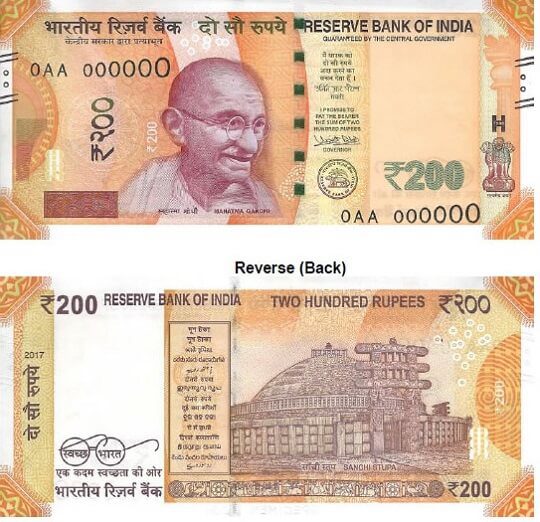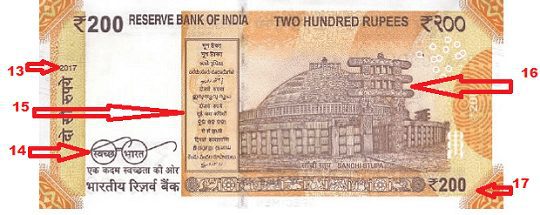The Reserve Bank of India will issue ₹ 200 denomination banknotes in the Mahatma Gandhi (New) Series. The base colour of the note is Bright Yellow. Rs 200 note has Motif of Sanchi Stupa on the reverse. The note has other designs, geometric patterns aligning with the overall colour scheme, both at the obverse and reverse. Dimension of the banknote will be 66 mm × 146 mm. With an aim to address the gap between low and high denomination currencies, Rs 200 notes were rolled out on August 25, 2017. This article describes the features of 200 Rs note and Sanchi Stupa the motif of which appears on the reverse of the note.
Table of Contents
Salient Features of 200 Rs Note Front or Obverse Front
1. See through register with denominational numeral 200
2. Latent image with denominational numeral 200
3. Denominational numeral २०० in Devnagari
4. Portrait of Mahatma Gandhi at the centre
5. Micro letters ‘RBI’, ‘भारत’, ‘India’ and ‘200’
6. Windowed security thread with inscriptions ‘भारत’ and RBI with colour shift. Colour of the thread changes from green to blue when the note is tilted
7. Guarantee Clause, Governor’s signature with Promise Clause and RBI emblem towards right of Mahatma Gandhi portrait
8. Denominational numeral with Rupee Symbol, ₹ 200 in colour changing ink (green to blue) on bottom right
9. Ashoka Pillar emblem on the right
10. Mahatma Gandhi portrait and electrotype (200) watermarks
11. Number panel with numerals growing from small to big on the top left side and bottom right side
12. For visually impaired
Intaglio or raised printing of Mahatma Gandhi portrait, Ashoka Pillar emblem, raised Identification mark H with micro-text ₹ 200, four angular bleed lines with two circles in between the lines both on the right and left sides
Salient Feature of 200 Rs Note Reverse (Back)
13. Year of printing of the note on the left
14. Swachh Bharat logo with slogan
15. Language panel
16. Motif of Sanchi Stupa
17. Denominational numeral २०० in Devnagari
Current Circulating Notes
| Value | Dimensions | Color | Description | Date of Issue | |
|---|---|---|---|---|---|
| Obverse | Reverse | ||||
| ₹1 | 97 × 63 mm | Blue | One-rupee coin | Sagar Samrat oil rig | 1994 / 2015 |
| ₹5 | 117 × 63 mm | Green | Mahatma Gandhi | Tractor | 2002 / 2009 |
| ₹10 | 137 × 63 mm | Orange-violet | Rhinoceros, elephant, tiger | 1996 / 2006 | |
| ₹20 | 147 × 63 mm | Red-orange | Mount Harriet, Port Blair | 2001 / 2006 | |
| ₹50 | 147 × 73 mm | Violet | Parliament of India | 1997 / 2005 | |
| ₹100 | 157 × 73 mm | Blue-green at centre, brown-purple at 2 sides | Himalaya Mountains | 1996 / 2005 | |
| ₹200 | 146 × 66 mm | Bright Yellow | Sanchi Stupa | 2017 | |
| ₹500 | 150 × 66 mm | Stone Gray | Red Fort | 2016 | |
| ₹2000 | 166 × 66 mm | Magenta | Mangalyaan | 2016 | |
About Sanchi Stupa
Sanchi, a UNESCO World heritage site located in Raisen district of Madhya Pradesh, Sanchi Stupas reveal richness of Indian heritage.T he Great Stupa at Sanchi is one of the oldest stone structure in India and was originally commissioned by emperor Ashoka in the 3rd century BCE.
The Great Stupa is built over the relics of the Buddha and thus to honour these relics, the Stupa is crowned with chatra. It is around 37 meters in diameter and over 16 meters high.
Sanchi Stupa is said to be one of the most organized structures with the best architectural designs that hail from the medieval period. A hemispherical brick structure, the Stupa is surrounded by four gateways called Toranas, each representing love, trust, courage, and peace. These gateways are beautifully crafted and sculptured. The gateway has as eye-catching architecture, with male and female tree murals carved on it. It is believed that these two spirits portray the human feelings and mental state. Buddhists believe that they are welcoming figurines and hence a “good omen” to have at the front.
This video describes the magnificent stupa of Sanchi in Madhya Pradesh and its architectural details.
Related articles:
- New 50 Rs Notes
- Currency Management: How does Indian Notes and Coins reach People
- New Rs 500 and Rs 2000 notes : Features,Comparison
- How does RBI deal with old notes, banned notes of 500 and 1000





